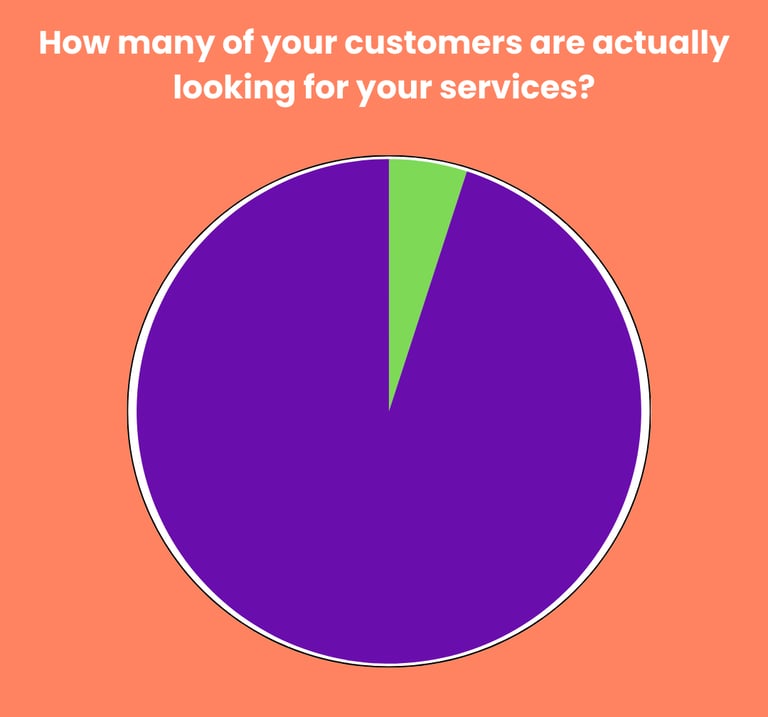The 95:5 Rule: Why Most of Your Customers Aren't Ready to Buy (Yet)
What if I told you that 95% of your potential customers aren't even in the market for your product or service right now? Read about the 95:5 rule which should influence your marketing.
MARKETING STRATEGYBRAND BUILDINGCLIENT ACQUISITION


Developing an effective marketing strategy requires understanding one crucial truth about customer behaviour: most of your potential customers aren't ready to buy right now. This insight forms the foundation of a revolutionary approach to marketing.
People often view marketing as a game of persuasion, convincing customers to buy now. But what if I told you that 95% of your potential customers aren't even in the market for your product or service right now? That's the insight behind the 95:5 rule, introduced by Professor John Dawes of the Ehrenberg-Bass Institute for Marketing Science.
Understanding the 95:5 Rule
The 95:5 rule states that at any given moment, only 5% of potential customers are actively looking to buy, whilst the remaining 95% are not in the market. This is especially relevant in B2B marketing, where purchase cycles can stretch over months or even years. It's equally applicable to B2C brands, particularly those selling high-value or infrequently purchased items.
This principle challenges the traditional marketing mindset that focuses heavily on short-term sales activation. Instead, it suggests that successful brands must take a longer-term approach to marketing strategy and brand building.
Essential Implications for Your Marketing Strategy
1. The Critical Role of Brand Building Since the vast majority of potential customers aren't actively buying, aggressive sales campaigns alone won't deliver optimal results. Smart brands focus on long-term brand-building efforts through:
Consistent brand messaging across all channels Authentic storytelling that resonates with target audiences Strategic thought leadership and content marketing Brand-focused advertising that builds mental availability
Take Dyson, for example. Despite selling products that consumers might purchase only every few years, they maintain consistent brand visibility through innovative storytelling and educational content about their engineering prowess.
2. Understanding Your Sector's Purchase Cycles
Different industries have vastly different buying cycles. A manufacturing company might only review its equipment suppliers every five years, whilst a marketing agency might gain new clients monthly. Understanding these patterns is crucial for your marketing strategy.
Key considerations include:
Setting realistic expectations for conversion rates based on your sector
Utilising data analytics to identify when buyers enter the market
Aligning marketing activities with natural purchase cycles
3. Creating Lasting Memory Structures
Your marketing strategy should prioritise building strong memory structures over driving immediate action. This means crafting messages that stick in customers' minds until they're ready to buy.
Effective techniques include:
Developing distinctive brand assets that are instantly recognisable
Creating emotional connections through storytelling
Maintaining consistency in visual and verbal brand identity
Consider how John Lewis has built its brand through emotional Christmas advertisements. While viewers might not purchase immediately, the emotional connection creates strong brand recall for future purchases.
4. Taking the Long-Term View
One of the most common pitfalls in marketing strategy is expecting instant results. With only 5% of potential customers actively buying, focusing solely on short-term sales tactics can lead to disappointment and inefficient spending.
Adopt a balanced approach by:
Tracking brand awareness and recall alongside sales metrics
Investing in consistent brand building whilst maintaining tactical sales activities
Developing patience in building lasting brand equity
Measuring Success in Brand Building
To effectively implement the 95:5 rule, consider tracking these key metrics:
Brand awareness and recall rates
Share of voice in your market
Brand sentiment and perception
Customer engagement levels across channels
Practical Implementation Steps
Audit your current marketing strategy: What percentage of your efforts focus on immediate sales versus brand building?
Develop a content calendar that balances brand storytelling with promotional content
Use distinctive brand assets consistently across all channels.
Implement regular brand tracking to measure long-term impact
Looking Ahead
The 95:5 rule reminds us that effective marketing strategy requires playing the long game. While maintaining tactical sales activities for the 5% who are ready to buy, successful brands invest significantly in building lasting relationships with the other 95%.
By understanding and applying this principle, you can develop a more balanced marketing strategy that drives both immediate results and long-term growth.


